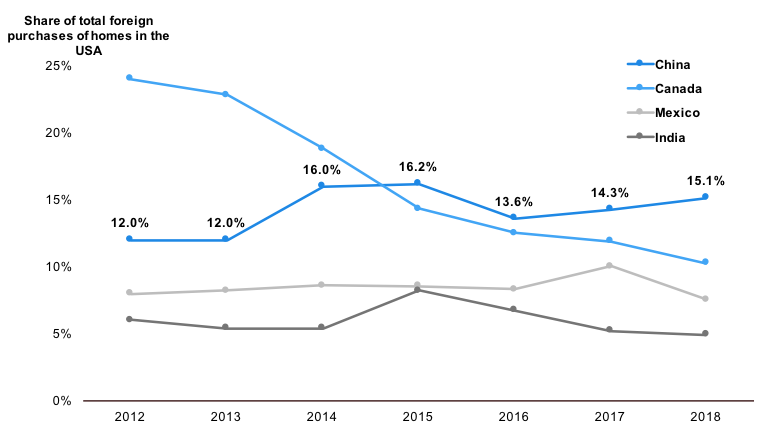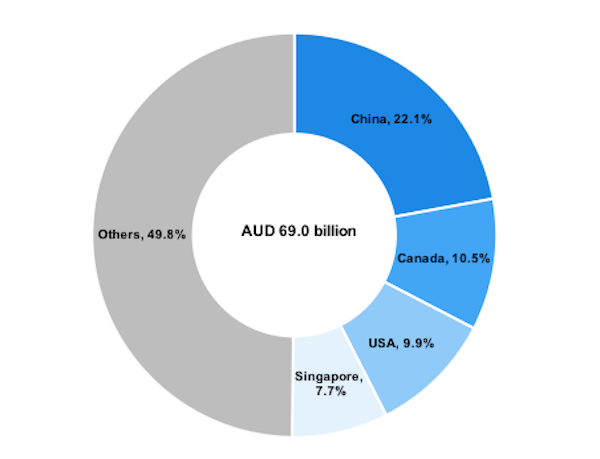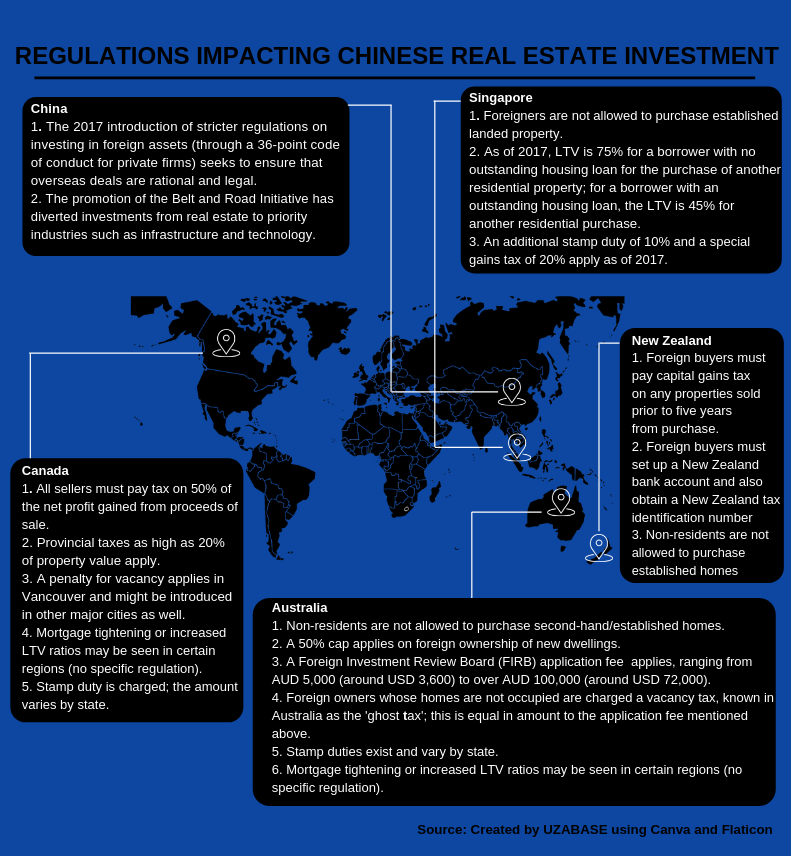Chinese Overseas Real Estate Investments: Can Policies Slow the Tide?
|
China’s outward-bound investment (OBI) in real estate grew exponentially to around USD 120 billion in 2017 from about USD 5 billion in 2010, making China the world’s second-largest cross-border investor in real estate, behind only the USA. This growth has been supported mainly by the unattractiveness of China’s domestic market and by an increase in China’s population of high-net-worth individuals who view foreign real estate as an attractive investment. |
|
In 2017, China’s OBI in residential real estate was largely concentrated in the USA (46% share), Hong Kong (25%), and Australia (21%). China’s interest in investing in US real estate stems partly from the strong investment security and higher-quality housing facilities that the US market offers and also from a motivation to obtain visa access. Meanwhile, Hong Kong’s attractiveness stems from its proximity and its quality of being a market easily understood by Chinese investors. Australia has also attracted a considerable share of Chinese investments in real estate, likely due to the country’s economic stability and its high quality of life. In addition, Malaysia was the only ASEAN country to attract a notable share (3%) of Chinese OBI. |
|
Possibly driven by this exponential growth in OBI in real estate, China and destination markets have both implemented policy barriers. In China, the government has promulgated a number of policies to regulate investment in foreign assets and curb money laundering since 2016. Australia, Canada, and New Zealand introduced tariffs on real estate purchases by foreigners in 2016 and 2017. Even with these polices, China’s OBI in real estate grew by 18.0% YoY in 2017, albeit slower than in 2016 (26.8% YoY) and 2015 (53.8% YoY). However, the policies have had a significant impact in Australia: Chinese FDI in Australian real estate fell 52.2% YoY in 2017. Moreover, Chinese real estate FDI fell 4% YoY in the USA in FY2018; we believe this downtrend is likely to continue, given the ongoing trade war between China and the USA. |
|
To some extent, Chinese interest in foreign residential real estate might shift to other Asian nations from the USA and Australia. Malaysia could be a key beneficiary in this potential shift, in our view; this should be underpinned by Malaysia’s position in China’s Belt and Road Initiative, which promotes Chinese investment in the region. |
|
China the World’s Second-Largest Cross-Border Real Estate Investor |
|
China is currently the second-largest source market for cross-border investment in real estate globally (behind only the USA), according to Cushman & Wakefield. China’s outward-bound investment (OBI) in real estate grew exponentially to around USD 120 billion in 2017 from about USD 5 billion in 2010, recording a 57.4% CAGR (based on data from Juwai.com, a Chinese website for buyers of overseas property). Juwai.com data indicates that 55.1% (or USD 65.9 billion) of China’s real estate OBI was on residential real estate, while the remaining 44.9% was directed towards commercial real estate. Further, an estimated 71.6% of Chinese overseas investors owned residential property overseas as of 2017, according to the same source. Given that residential real estate investments form the bulk of this, in this report we analyse the trends and the dynamics of China’s residential real estate investments. |
|
China’s OBI on Real Estate Up Exponentially Since 2010 |
|
|
|
Source: Juwai.com, “Chinese Global Property Investment Report 2018” |
|
This rapid growth in China’s real estate investment volume could be attributed to a number of factors: |
|
01. Purchasing a home in China offers relatively low affordability and returns amidst the housing bubble. Wealthy Chinese are therefore purchasing second homes overseas, mainly for investment purposes. Rapidly increasing prices have made China one of most unaffordable countries for home purchases. These high prices have also resulted in relatively low returns on apartment yields (refer to the table below, titled “High Affordability and Yields Makes the USA a Popular Investment Destination”). The situation prevails despite the Chinese government’s introduction of policies to counter it since 2007. Some of the policies and legislations introduced are as follows: |
|
• Minimum down-payment rates: First-time buyers need to make a 30% down-payment, and second home buyers a 60% down-payment. |
|
• Higher mortgage rates resulting from tighter liquidity: In 2017, China’s central bank promoted the reinforcement of mortgage risk management in order to curtail financing in the real estate market. This in turn has led to an increase in housing loan interest rates for first- and second-home buyers at the Beijing branches of six major Chinese banks. Leading mortgage lenders such as the China Construction Bank terminated their discounts for first-time home buyers. Furthermore, the Agriculture Bank of China discontinued its preferential mortgage rates for first-home buyers. |
|
• Controls on inter-city investment and multi-home ownership: Property investors are now required to diversify their property investment portfolio in order to meet the new criteria on home loans. |
|
As per Juwai.com, real estate remains the most favoured form of foreign investment among wealthy Chinese investors. According to a report by Bain & Company (a global management consultancy firm) and China Merchants Bank, around 11% of Chinese high-net-worth individuals (HNWIs) regarded real estate as their most favoured asset class in 2017, just behind insurance products, but ahead of other options such as stocks, bonds, and overseas funds. Furthermore, the Hurun Report ‘Chinese Luxury Consumer Survey 2017’ stated that real estate investments had overtaken stocks as the most popular choice of investment for Chinese HNWIs in 2017. |
|
Increase in HNWIs and Investible Wealth Could Underpin Demand for Foreign Real Estate |
|
|
|
Source: Bain & Company; China Merchants Bank |
|
02. Less-attractive returns in the equity market (following the stock market crash in 2015), combined with the labelling of the bond market as risky and under-regulated. This is likely to have made overseas property a key asset class for a country with a high savings rate and a long economic boom. |
|
In this report, we consider how China’s OBI in residential real estate has impacted key relevant markets around the world. |
|
USA, Hong Kong, and Australia the Key Destinations for China’s OBI in Residential Real Estate |
|
Juwai.com data found that a little over 90% of China’s OBI in residential real estate is concentrated in three countries: the USA (a 46.1% share), Hong Kong (24.6%), and Australia (21.4%). In effect, six countries accounted for nearly all of China’s residential real estate investments in 2017. |
|
Six Countries Account for Almost All of China’s Residential Real Estate OBI, 2017 |
|
|
|
Source: Juwai.com, “Chinese Global Property Investment Report 2018” |
|
China’s interest in investing in the USA stems mainly from the need for primary residences, with around 39% of Chinese buyers searching for a primary residence in 2017. This was followed by buyers purchasing homes for investment purposes (21%) and for vacation purposes and as secondary homes (18%) in 2017. Data from US sources confirms this trend: China has been the largest contributor to home sales to foreigners in the USA since FY2015, the year in which it surpassed Canada. Some of the reasons the USA has become a prime real estate destination for Chinese investors are as follows: |
|
1. Strong investment security: The USA’s solid legal system and private property rights have attracted Chinese investors to the market, as it offers security and stability for long-term investments. |
|
2. Better housing quality: Advanced construction standards in the USA mean US homes have an average lifespan of around 74 years, i.e. 2.2x the lifespan of a Chinese home (around 33 years). This has made US housing a superior long-term investment prospect. |
|
3. Superior education facilities: The presence of Ivy League education institutions has made the USA one of the best destinations for education. This has increased the US housing market’s attractiveness to Chinese investors, given that education is a strong stimulus for Chinese overseas real estate investment. |
|
4. Easy visa access: The USA has revamped its visa policy with respect to China by offering long-term investor and emigration visas, as well as shorter-term two-year multiple entry visas. |
|
Chinese Buyers Purchase Homes Mainly to Own a Primary Residence or for Investment Purposes in the USA, 2017 |
|
|
|
Source: National Association of Realtors, “Profile of International Transactions in U.S. Residential Real Estate 2018” |
|
High Affordability and Yields Make the USA a Popular Investment Destination |
|
|
|
Source: Numbeo |
|
China the Largest Purchaser of Homes in USA Since 2015 |
|
|
|
Source: National Association of Realtors, “Profile of International Transactions in U.S. Residential Real Estate 2018” |
|
Note: Data for the year ending 31 March |
|
Meanwhile, Hong Kong attracted China’s second-highest OBI in residential real estate. Hong Kong real estate is relatively costly (the price-to-income ratio for apartment houses stood at 46.9 as of October 2018) and generates low returns (gross rental yields on apartments stood at 1.9% as of 1H2018). Hong Kong’s attractiveness could therefore be its proximity and the fact of its being a market easily understood by Chinese investors, who also have the advantage of access to capital. Hong Kong enterprise groups (HKEGs) that were engaged in investment and holding, real estate, and professional and business services dominated (share of 67.5%) Hong Kong’s total inward direct investments in 2016 (latest information available), according to the Census and Statistics Department of Hong Kong. |
|
Australia captured China’s third-highest OBI in residential real estate, despite not ranking among the world’s top ten residential real estate markets. Australia’s attractiveness is likely due to the country’s economic stability (the Australian economy is rated AAA by all three major credit agencies in the world) and the High quality of life. Australia ranked fifth in terms of quality of life and seventh in the category of overall best country across the globe in 2017, as per the ‘Best Countries 2018’ report by Y&R’s BAV Group and Wharton School, University of Pennsylvania. |
|
China was therefore Australia’s largest source of FDI in real estate. In FY2017 (financial year ending 30 June), China accounted for the largest proportion of FDI in Australia’s real estate industry, followed by Canada, the USA, and Singapore. |
|
China Dominated FDI in Real Estate in Australia, Attracted by Economic Stability and Better Quality of Life, FY2017 |
|
|
|
Source: Foreign Investment Review Board, “Annual Report 2016–17”Note: Data for the financial year ending 30 June |
|
Malaysia attracted China’s fourth-highest OBI in residential real estate; it was the only ASEAN country to attract investment from China in 2017. The Malaysian housing market is in oversupply, specifically in the mid- to high-range housing segment (which Malaysians cannot afford), according to both Bank Negara Malaysia (BNM; the central bank of Malaysia) and the National Property Information Centre (NAPIC; the government entity established to monitor the property market). As a result, housing demand and in turn prices have been growing at a subdued rate in recent years. Numbeo states that both affordability and returns from apartments in Malaysia have been worsening. |
|
Foreign investors have been the main drivers for high-end property in Malaysia, supported by the country’s lax regulations on foreign investment in real estate. In addition, Chinese investors have been attracted to the country’s high quality healthcare facilities, easy access to large commercial malls, and low cost of living. According to the American Enterprise Institute (AEI, a public policy research institute), Chinese investment in Malaysian real estate stood at around USD 280 million, i.e. 35.4% of China’s total FDI to Malaysia and 0.2% of total FDI to Malaysia from all countries. |
|
Real Estate OBI Facing Policy Hurdles Both Within China and from Destination Markets |
|
In response to the exponential growth in Chinese real estate OBI, China as well as destination markets have both implemented policy barriers. In China, the government has promulgated a number of policies to regulate investment in foreign assets and curb money laundering since 2016, with the aim of routing these funds to higher-priority segments such as mining, agriculture, and technology. No foreign property acquisitions were carried out between August 2017 and year-end 2017, according to BBVA. |
|
Separately, Australia, Canada, and New Zealand introduced tariffs on real estate purchases by foreigners in 2016 and 2017. Below are some of the restrictions implemented in major cities across the world in relation to property purchases by foreigners. |
|
Even with above mentioned these polices, China’s OBI in real estate still grew 18.0% in 2017, although slower than the growth in 2016 (26.8%) and 2015 (53.8%), as per data from Juwei.com. However, there was a notable impact in Australia and USA too also saw Chinese Real Estate FDI declining in FY2018 (details on Australia and USA markets discussed below). |
|
|
|
Chinese Investment in Australian Real Estate Declined Following the Implementation of Controls, While Canada Continued to Experience Higher Investments |
|
The Australian government started introducing reforms to the housing market in 2016. In New South Wales, the stamp duty surcharge for foreign investors was increased to 8% from 4%, while the annual land tax surcharge was raised to 2% from 0.75%, according to the 2017 Budget. In Victoria, foreign investors have had to pay an additional 7% tax on top of their land transfer duty since July 2016. As of FY2016 (financial year ending 30 June, latest information available), New South Wales had the highest share of housing stock (30.9%) followed by Victoria (25.6%). This in turn has weakened Chinese interest in Australian real estate: Chinese FDI in Australian real estate fell 52.2% YoY to around AUD 15.3 billion in FY2017, after having risen at a CAGR of 66.2% over FY2012–16 to AUD 31.9 billion. |
|
Drop in Real Estate FDI to Australia Further Depresses Home Sales |
|
|
|
Source: Foreign Investment Review Board (Australia) Annual Reports and Trading Economics |
|
Note: FDI data for the financial year ending 30 June |
|
Similar to Australia, Canada imposed stricter regulations on the purchase of homes by foreigners in 2016, beginning with the imposition of a 15% tax on foreign home buyers, with the specific intent of deterring investment from China. In 2018, the tax was raised to 20% for certain regions in British Columbia. In addition, there has been debate on the introduction of a speculation tax in the region, targeting foreign and domestic investors who either do not pay income tax in British Columbia or do not live in the homes they purchase. According to the American Enterprise Institute (AIE — a public policy research institute), Chinese FDI in the entertainment and real estate segment (a proxy for Chinese FDI in the real estate segment, due to a lack of data) formed around 27% of total Chinese FDI in Canada in 2017 and 10.4% of total FDI in Canada the same year. However, Chinese investment in this segment rose 69.9% YoY to USD 3.9 billion in 2017, despite the government’s efforts to cut foreign investment. Given the information available, further analysis of the impact of Chinese investment on the real estate market is not possible. |
|
More importantly, the largest destination market, the USA, is yet to introduce regulations specifically targeting Chinese investment in the housing market. Nevertheless, the value of housing units purchased by Chinese individuals declined 4.1% YoY to USD 30.4 billion in FY2018 (financial year ending 31 March), while the number of residential units sold to Chinese purchasers remained stable at 40,400 units. This overall decline can be attributed to the above-mentioned OBI-related regulations introduced by the Chinese government towards the latter half of 2017. Furthermore, there has been widespread negative sentiment about Chinese investment in the USA, and this has created uncertainty for foreign investors, especially the Chinese. Furthermore, the faster-paced decline in housing value than units is attributed to those Chinese investors remaining in the market who focus on lower-priced properties. This is a result of the stricter enforcement of a forex rule on Chinese individuals which in turn has left many Chinese buyers targeting lower-priced properties of USD 1–5 million. Juwai.com states that 20.7% of Chinese buyers using the website searched for properties in the range of USD 1–5 million in 2017. |
|
Chinese Real Estate FDI in USA Down in FY2018 due to OBI Restrictions by Chinese Government |
|
|
|
Source: National Association of Realtors, “Profile of International Transactions in U.S. Residential Real Estate 2018” |
|
Note: Data for the year ending 31 March |
|
Chinese Investment Flow to the US Housing Market Likely to Decline Given Trade War Tensions |
|
It is not yet clear whether the Trump administration will introduce regulations to curb foreign investment in the US housing market or whether it will avoid doing so, similar to Malaysia. Meanwhile, the US housing market appears stable, and the Trump administration is unlikely to introduce taxes on foreign investment in housing, given the turnaround in demand for home purchases. Juwai.com expects the USA to maintain its present market conditions rather than introduce any regulations to curb foreign investments. |
|
However, the ongoing trade war between the USA and China is likely to impact investment flow. According to the Financial Times and CNBC (a television business news channel), Chinese interest in the US housing market would decline if the Trump administration introduces more trade restrictions and policies. However, this is unlikely to have a major impact on the market, as the decline in sales to foreign investors is likely to be offset by higher domestic sales, supported by the changing lifestyles of millennials. The National Realtors Association (NAR, a trade association for realtors) predicts that new home sales will rise by around 7% YoY, while existing home sales will rise by only 2.5% YoY by the end of 2018. |
|
Could Malaysia be the Next Australia for Chinese Property Investments? |
|
Despite the negative sentiment about Chinese investment in the Malaysian housing market, the Malaysian government has not implemented regulations to deter foreign investments. This could be an attempt to maintain demand, as Malaysia is experiencing an oversupply of mid- to high-end housing. |
|
Further, Malaysia has played an integral part in China’s Belt and Road Initiative (BRI), being a gateway to ASEAN and given the capital Kuala Lumpur’s role in providing market stability, solid returns, and a mature outlook (for more details on BRI, please refer to the SPEEDA Insight ‘China’s One Belt One Road Projects in ASEAN’ of 24 October 2018). |
|
As such, it is likely that Kuala Lumpur and Malaysia will remain on Chinese investors’ global radar. Furthermore, the oversupply in Malaysia’s domestic market has led developers to lower home prices, thereby making home purchases in the country cheaper. Juwai.com forecasts that Chinese investment in Malaysia’s residential real estate could double by 2025E, driven by the investment market and education. |













